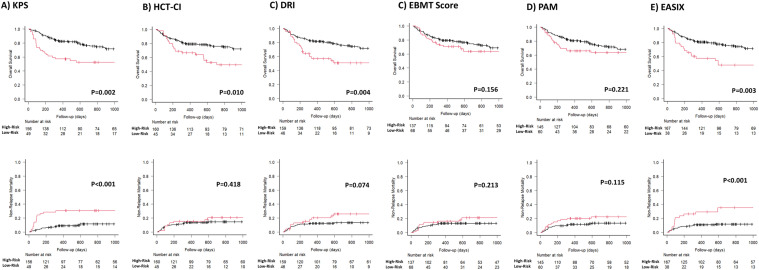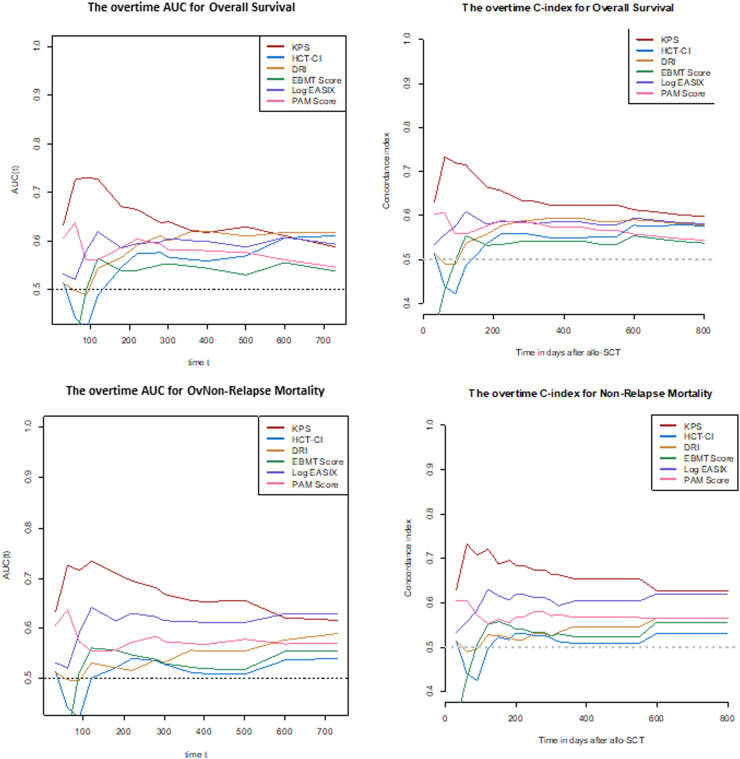Applicability and validation of different prognostic scores in allogeneic hematopoietic cell transplant (HCT) in the post-transplant cyclophosphamide era
IF 1.6
Q3 HEMATOLOGY
引用次数: 0
Abstract
We investigated the predictive capacity of six prognostic indices [Karnofsky Performance Status (KPS), Hematopoietic Cell Transplant-Specific Comorbidity Index (HCT-CI), Disease Risk Index (DRI), European Bone Marrow Transplantation (EBMT) and Revised Pre-Transplantation Assessment of Mortality (rPAM) Scores and Endothelial Activation and Stress Index (EASIX)] in 205 adults undergoing post-transplant cyclophosphamide (PTCy)-based allo-HCT. KPS, HCT-CI, DRI and EASIX grouped patients into higher and lower risk strata. KPS and EASIX maintained appropriate discrimination for OS prediction across the first 2 years after allo-HCT [receiver operating characteristic curve (area under the curve (AUC) > 55 %)]. The discriminative capacity of DRI and HCT-CI increased during the post-transplant period, with a peak of prediction at 2 years (AUC of 61.1 % and 61.8 %). The maximum rPAM discriminative capacity was at 1 year (1-year AUC of 58.2 %). The predictive capacity of the EBMT score was not demonstrated. This study validates the discrimination capacity for OS prediction of KPS, HCT-CI, DRI and EASIX in PTCy-based allo-HCT.


异基因造血细胞移植(HCT)不同预后评分在移植后环磷酰胺时代的适用性和验证。
我们研究了6项预后指标[Carnofsky性能状态(KPS)、造血细胞移植特异性共病指数(HCT-CI)、疾病风险指数(DRI)、欧洲骨髓移植(EBMT)和修订的移植前死亡率评估(rPAM)评分以及内皮激活和应力指数(EASIX)]对205名接受移植后环磷酰胺(PTCy)为基础的allo-HCT。KPS、HCT-CI、DRI和EASIX将患者分为高风险和低风险阶层。在allo-HCT后的前2年,KPS和EASIX对OS预测保持了适当的区分[受试者工作特征曲线(曲线下面积(AUC)>55%)]。DRI和HCT-CI的辨别能力在移植后增加,在2年时达到预测峰值(AUC分别为61.1%和61.8%)。最大rPAM辨别能力在1年时达到(1年AUC为58.2%)。EBMT评分的预测能力未得到证实。本研究验证了基于PTCy的allo-HCT中KPS、HCT-CI、DRI和EASIX对OS预测的判别能力。
本文章由计算机程序翻译,如有差异,请以英文原文为准。
求助全文
约1分钟内获得全文
求助全文
来源期刊

Hematology, Transfusion and Cell Therapy
Multiple-
CiteScore
2.40
自引率
4.80%
发文量
1419
审稿时长
30 weeks
 求助内容:
求助内容: 应助结果提醒方式:
应助结果提醒方式:


